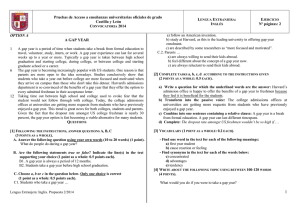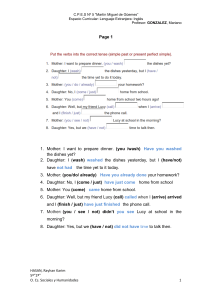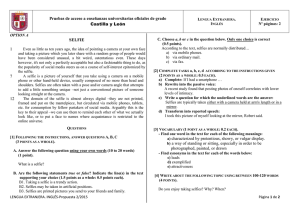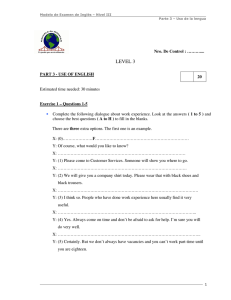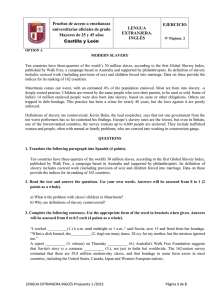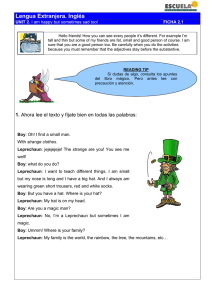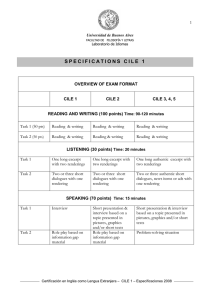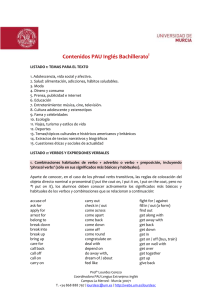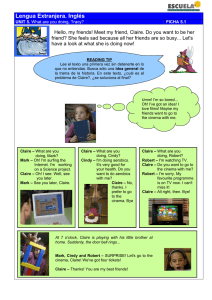OPTION A RITA LEVI-MONTALCINI: A LIFE Rita Levi
Anuncio
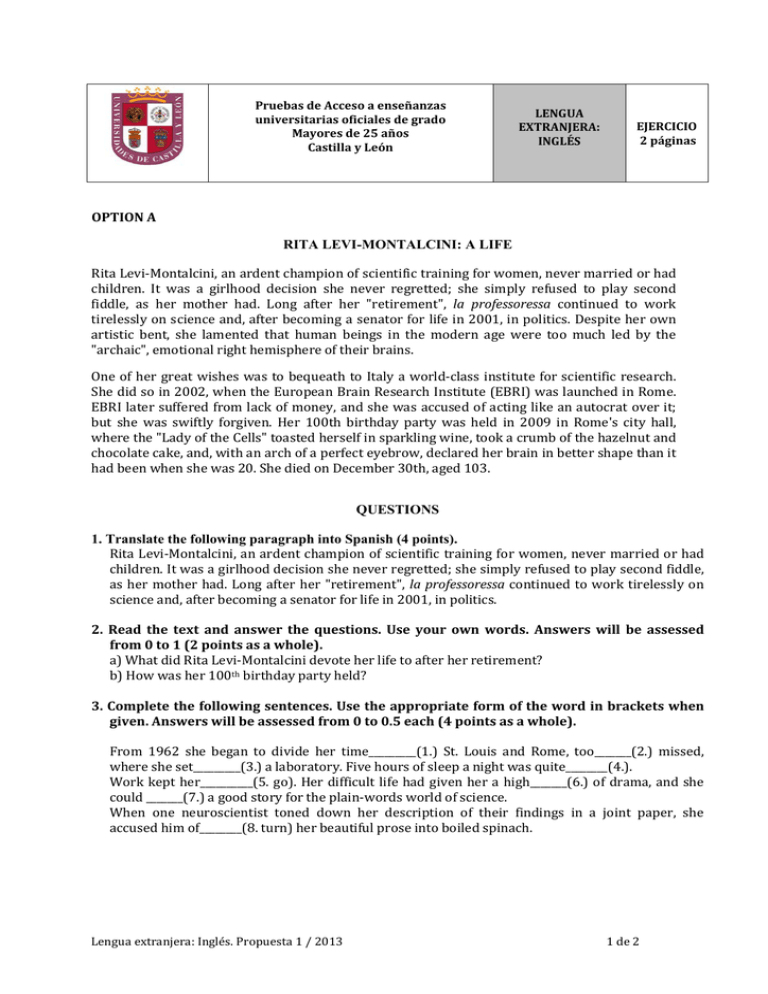
Pruebas de Acceso a enseñanzas universitarias oficiales de grado Mayores de 25 años Castilla y León LENGUA EXTRANJERA: INGLÉS EJERCICIO 2 páginas OPTION A RITA LEVI-MONTALCINI: A LIFE Rita Levi-Montalcini, an ardent champion of scientific training for women, never married or had children. It was a girlhood decision she never regretted; she simply refused to play second fiddle, as her mother had. Long after her "retirement", la professoressa continued to work tirelessly on science and, after becoming a senator for life in 2001, in politics. Despite her own artistic bent, she lamented that human beings in the modern age were too much led by the "archaic", emotional right hemisphere of their brains. One of her great wishes was to bequeath to Italy a world-class institute for scientific research. She did so in 2002, when the European Brain Research Institute (EBRI) was launched in Rome. EBRI later suffered from lack of money, and she was accused of acting like an autocrat over it; but she was swiftly forgiven. Her 100th birthday party was held in 2009 in Rome's city hall, where the "Lady of the Cells" toasted herself in sparkling wine, took a crumb of the hazelnut and chocolate cake, and, with an arch of a perfect eyebrow, declared her brain in better shape than it had been when she was 20. She died on December 30th, aged 103. QUESTIONS 1. Translate the following paragraph into Spanish (4 points). Rita Levi-Montalcini, an ardent champion of scientific training for women, never married or had children. It was a girlhood decision she never regretted; she simply refused to play second fiddle, as her mother had. Long after her "retirement", la professoressa continued to work tirelessly on science and, after becoming a senator for life in 2001, in politics. 2. Read the text and answer the questions. Use your own words. Answers will be assessed from 0 to 1 (2 points as a whole). a) What did Rita Levi-Montalcini devote her life to after her retirement? b) How was her 100th birthday party held? 3. Complete the following sentences. Use the appropriate form of the word in brackets when given. Answers will be assessed from 0 to 0.5 each (4 points as a whole). From 1962 she began to divide her time_________(1.) St. Louis and Rome, too_______(2.) missed, where she set_________(3.) a laboratory. Five hours of sleep a night was quite________(4.). Work kept her__________(5. go). Her difficult life had given her a high_______(6.) of drama, and she could _______(7.) a good story for the plain-words world of science. When one neuroscientist toned down her description of their findings in a joint paper, she accused him of________(8. turn) her beautiful prose into boiled spinach. Lengua extranjera: Inglés. Propuesta 1 / 2013 1 de 2 Pruebas de Acceso a enseñanzas universitarias oficiales de grado Mayores de 25 años Castilla y León LENGUA EXTRANJERA: INGLÉS EJERCICIO 2 páginas OPTION B WHAT IS MIDDLE CLASS IN MANHATTAN? Drive through almost any neighborhood around the country, and class divisions are as clear as the gate around one community or the grittiness of another. From the footprint of the house to the gleam on the car in the driveway, it is not hard to guess the economic status of the people who live there. Manhattan, however, is not like most places. Its 1.6 million residents hide in a forest of tall buildings, and even the city’s elite take the subway. But middle-class neighborhoods do not really exist in Manhattan — probably the only place in the United States where a $5.5 million condo with a teak closet and mother-of-pearl wall tile shares a block with a public housing project. There is no single, formal definition of class status in this country. Most people like to think of themselves as middle class. It feels good, after all, and more egalitarian than proclaiming yourself to be rich or poor. A $70,000 annual income is middle class for a family of four, according to the median response in a recent survey, and yet people at a wide range of income levels, including those making less than $30,000 and more than $100,000 a year, said they, too, belonged to the middle. QUESTIONS 1. Translate the following paragraph into Spanish (4 points). Manhattan, is not like most places. Its 1.6 million residents hide in a forest of tall buildings, and even the city’s elite take the subway. But middle-class neighborhoods do not really exist in Manhattan — probably the only place in the United States where a $5.5 million condo with a teak closet and motherof-pearl wall tile shares a block with a public housing project. 2. Read the text and answer the questions. Use your own words. Answers will be assessed from 0 to 1 (2 points as a whole). 1. 2. How does the author distinguish middle class neighbourhoods around the country? Why do people like to consider themselves middle class? 3. Complete the following sentences. Use the appropriate form of the word in brackets when given. Answers will be assessed from 0 to 0.5 each (4 points as a whole). The average Manhattan apartment, at $3,973 a month, _________ (1. cost) almost $2,800 more ________ (2.) the average rental nationwide. The average sale price of a __________ (3.) in Manhattan last year _________ (4. be) $1.46 million, while the average sale price for a new home in the United States was just under $230,000. Ask people ___________ (5.) the country, “Are you middle class?” and the answer _____________ (6. be likely) to be yes. But ask the same question in Manhattan, and people often pause in confusion, unsure exactly __________ (7.) you __________ (8. mean) Lengua extranjera: Inglés. Propuesta 1 / 2013 2 de 2

